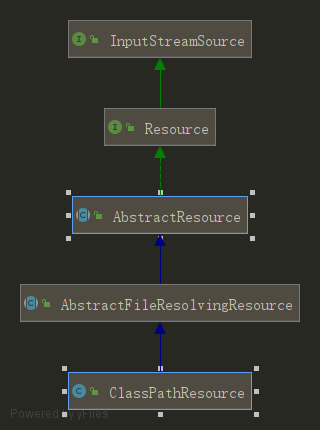Spring ClassPathResource
ClassPathResource用于加载资源文件,如果类路径资源文件位于文件系统中,支持解析为File,但是不用于JAR中的资源。
org.springframework.core.io.ClassPathResource位于Spring核心core下,用以表达类路径下的资源 。
其继承实现关系如下图:

ClasspathResource类的主要属性变量和构造方法如下
//资源文件路径
private final String path;
//通过类加载器加载资源
@Nullable
private ClassLoader classLoader;
//通过Class类加载资源文件
@Nullable
private Class<?> clazz;
通过资源路径和classLoader创建ClassPathResource对象,classLoader默认为null
public ClassPathResource(String path, @Nullable ClassLoader classLoader) {
Assert.notNull(path, "Path must not be null");
//规范会配置文件路径
String pathToUse = StringUtils.cleanPath(path);
if (pathToUse.startsWith("/")) {
pathToUse = pathToUse.substring(1);
}
this.path = pathToUse;
//获取类加载器
this.classLoader = (classLoader != null ? classLoader : ClassUtils.getDefaultClassLoader());
}
关于StringUtils,可以参考: Spring中的SpringUtils
// 通过类路径和给定的Class类创建ClassPathResource对象
public ClassPathResource(String path, @Nullable Class<?> clazz) {
Assert.notNull(path, "Path must not be null");
//规范化资源文件路径
this.path = StringUtils.cleanPath(path);
this.clazz = clazz;
}
getInputStream()方法,为给定的类路径资源打开一个InputStream
public InputStream getInputStream() throws IOException {
InputStream is;
//判断clazz对象是否为null,不为null的话,获取InputStream对象
if (this.clazz != null) {
is = this.clazz.getResourceAsStream(this.path);
}
//判断classLoader对象是否为null,不为null的话,获取InputStream对象
else if (this.classLoader != null) {
is = this.classLoader.getResourceAsStream(this.path);
}
//获取InputStream对象
else {
is = ClassLoader.getSystemResourceAsStream(this.path);
}
//抛出异常
if (is == null) {
throw new FileNotFoundException(getDescription() + " cannot be opened because it does not exist");
}
return is;
}
getURL():返回底层类路径资源的URL
@Override
public URL getURL() throws IOException {
URL url = resolveURL();
if (url == null) {
throw new FileNotFoundException(getDescription() + " cannot be resolved to URL because it does not exist");
}
return url;
}
如下为测试代码:
//Resource resource=new ClassPathResource("resource/conf.txt",Thread.currentThread().getContextClassLoader());
// Resource resource=new ClassPathResource("resource/conf.txt",ResourceMain.class.getClassLoader());
Resource resource=new ClassPathResource("resource/conf.txt");
InputStream inputStream = resource.getInputStream();
ByteArrayOutputStream bts=new ByteArrayOutputStream();
int i;
while ((i=inputStream.read())!=-1){
bts.write(i);
}
System.out.println(bts.toString());
System.out.println(resource);
System.out.println(resource.getURI());
System.out.println(resource.getURL());
System.out.println(resource.getDescription());
System.out.println(resource.getFile());
System.out.println(resource.getFilename());
相关源码参考: github